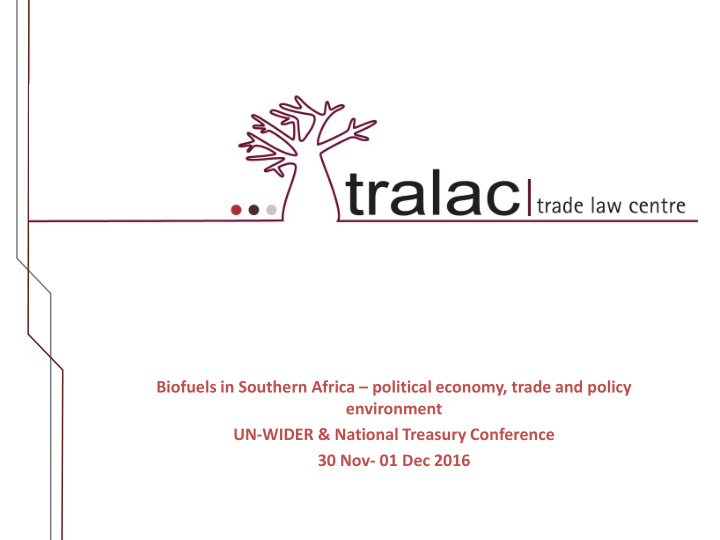



Biofuels in Southern Africa – political economy, trade and policy environment UN-WIDER & National Treasury Conference 30 Nov- 01 Dec 2016
Big Picture – biofuels in Southern Africa • Leverage abundant resources; • Reduce dependency on imports; • Potential to produce for export; • Development of policy & regulatory frameworks; • This coupled with incentives mechanism to spur supply & demand
Policy tools often used to introduce bioethanol Blending mandates form part of the policy framework to incentivise biofuels demand e.g. Malawi – E10 (1982); Moz – E10 (2012*); South Africa – E2 (2015*); Zambia – E10 (planned)
Global trends • US; Brazil and EU, main producers and consumers of biofuels (approximate combined share of 80%) • Global trade in bioethanol – expectations were that major exporters (US; Br; Arg) would supply EU mkt – but rulings in 2011 anti-dumping; CV duties – opportunity for SSA to supply; • Concerns over sustainability of external supply – reforms which increased barriers into EU and thus limited profitability for e.g. SSA to export; • Falling agric prices of feedstock made it for EU to produce; In 2014 – EU was 99%(bioethanol) & 97% (biodiesel) self sufficiency
Regional trends - Production • Reasons for this include factors related to developments in global energy and commodity markets in general and biofuel markets in particular, and in domestic experiences of attempting to implement land-intensive feedstocks;
Regional trends – Policy & Political Economy
Regional trends – Trade Policy • WTO Principles – (MFN; National Treatment) – competition from low cost producers; • Incentives – treatment of subsidies; classification of biofuels under WTO; • SADC level – no perceived restrictions to trade (both in feedstocks and biofuels) – potential for dvpt of regional industry; - SADC FTA; • Challenge – biofuels not priority at SADC level although highlighted – electricity supply; • Furthermore – weak institutions (no dispute settlement mechanism) – uncertainty for investors; and traders (NTBs)
In Conclusion • Beyond biofuels, the driver of political will is social pressure - severe poverty, low-levels of investment, poor infrastructure, health care, education and food security are high on the priority list for SADC governments; • At the domestic level, there are currently unclear signals of commitment from governments to enforce biofuel mandates through either purchasing offtake agreements or requiring refineries to blend biofuels with fossil fuels; • Reviving interest in biofuels at the regional level would likely require firmer interest from national governments; • For investors, strong incentives are necessary to spur the previously high levels of interest in biofuels that have currently waned on the back of low oil prices
Recommend
More recommend